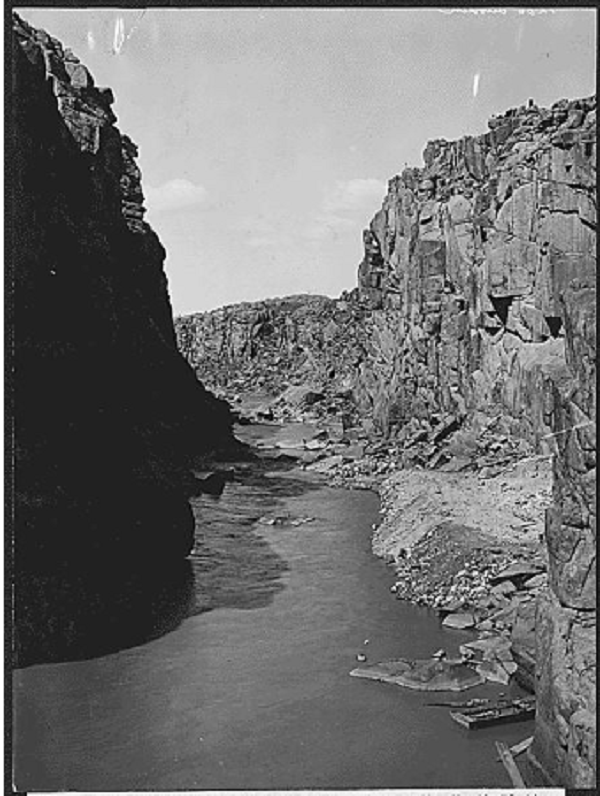One of the less noted, but very notable, aspects of this story: Rather than retaliating, the U.S. Army declared that Grattan had exceeded his authority. An explosive situation was not allowed to escalate, but the seeds of distrust and future violence had been sewn. Gratten had handled the entire situation very badly. But the Army, in its follow-up, was wise to regard his actions as improper, in spite of the disaster it was to his men.
1878 Robert Widdowfield and Union Pacific detective Tip Vincent killed in the line of duty by Big Nose George Parrott's gang near Elk Mountain. Widdowfield and Vincent were attempting to apprehend the gang which had attempted to rob a train.
1898 Iron Post office established. Attribution: Wyoming Places.
1941 The Wyoming Aircraft School won approval from Civil Aeronautics Authority. Attribution: Wyoming State Historical Society.
1942 The Evacuette, a newpaper of the North Portland Assembly Area, ran as a headline story that Japanese internees, the newspaper's audience, would be going to Wyoming.
1950 300th AFA, Wyoming Army National Guard, Federalized for service in the Korean War.
1953 First letters sent out in an effort to organize a Wyoming State Historical Society. Letter sent out by Lola Homsher. Attribution: Wyoming State Historical Society.
1998 The Manges Cabin in Grand Teton National Park, added to the National Registry of Historic Places. Attribution: On This Day.
2015 Lex Anteinternet: And the band played on. . .well maybe not so much
Earlier this week we ran this:
Lex Anteinternet: And the band played on: In Saturday's Tribune an article appeared noting, again, the loss of over 3,000 oil industry jobs in Wyoming, and a 50% reduction i...
Yesterday (August 19), however, Governor Mead sang a different tune, and one that
wasn't nearly so rosy. We have to given him credit for that.
Mead, in a press conference flaty stated that Wyoming is entering a
"difficult period" and that the State may need to consider tapping into
its "rainy day" funds. For those who might not be aware of what those
are, they're funds that the state specifically puts aside for stressed
times.
Governors do not, to my recollection, ever suggest this. That's truly a
dramatic statement for a sitting Governor, indicating just how dire the
state's condition may be. That Mead would suggest considering it speaks
very much in his favor, as this has tended to be something that simply
isn't discussed. Reactions to the Governor's speech have been generally
favorable, although there's no present support for actually tapping
into the funds. Mead, of course, wasn't requesting to do so right now,
only indicating that it might become necessary.
2017 Casper Eclipse Festival: August 19-21, 2017. And a note on the Eclipse in general.
New downtown Rotary sidewalk clock.
Picking up my trailer, which I had loaned out to friends
Interesting event.
2017 Casper Eclipse Festival: August 19-21, 2017. And a note on the Eclipse in general.
Newly opened Casper bar, The Gaslight Social.
As
Casper was right in the center of the 2017 Solar Eclipse, it took
advantage of the situation and had a three day festival to commemorate
it. The festival featured the openings, basically, of three new bars
(or one bar/restaurant reopening, one new bar/restaurant and one new
bar) and a new city feature, a downtown plaza. It was well attended.
Downtown
revelers and a carriage. Casper, unlike Fort Collins or even,
occasionally, Denver, generally doesn't have horse drawn carriages
downtown.
There were
wildly varying predictions for the eclipse. Frankly, I doubted some of
them. But maybe more of them came true than I would have guessed.
Map
showing where people had come from to view the eclipse. Some of the
locations were so surprising, I wonder if they were really true.
Over
1,000,000 people, according to the Star Tribune, entered the state
during the eclipse. Assuming that's correct, that means that the
state's population tripled yesterday. Having said that, it didn't
appear to be the case that Casper's population more than doubled, as had
been predicted. I know that not all of the camping spots filled that
had been predicted to, although perhaps many did. I also know that
people were camping right in the neighborhood, in front of people's
houses that they knew.
This
doesn't do this map justice. There were visitors, according to the
map, from Greenland, Ascension Island, and North Korea. All quite
surprising, if true.
Europe
seemed pretty well represented. I met one Irish visitor who had just
left the Wonder Bar, which has a nice restaurant. Apparently he hadn't
realized that as he asked me and my son for directions to "a pub" so he
could get something to eat. He was surprised when I directed him back
to the Wonder Bar.
New downtown plaza. I was skeptical that this would be complete on time.
It's not everyday you see a municipal judge on the guitar.
Picking up my trailer, which I had loaned out to friends
I'm
included amongst those that had camping visitors. Some good friends of
mine were in town for the eclipse. They'd planned on staying in
Gillette and driving down, but I loaned them my camp trailer and let
them camp near our garden land. That became three couples by the time of
the eclipse. This land has never had residents, although the
neighboring land does and has for quite some time, so I suppose its
population increased from 0 to six.
Another
old friend of mine drove up from Salt Lake to Riverton, where they also
experienced an influx. And I guess the Jackson Hole Airport received a
huge corporate jet boost.









































































